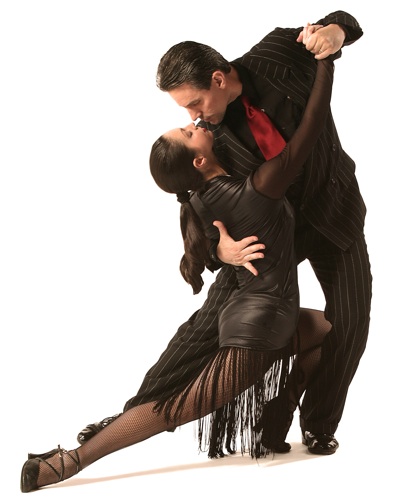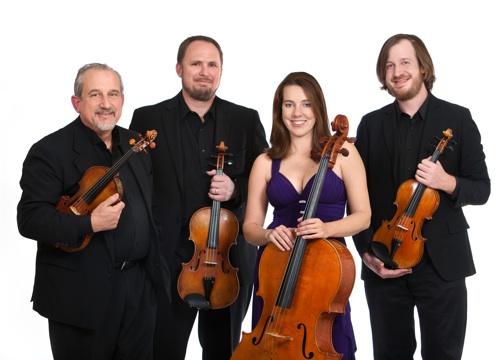Bridging the divide between classical music and the dockside brothels of Buenos Aires, bandoneon player and composer Astor Piazzolla first used popular counter rhythms, sharp whips, and an accordion’s sonority alongside traditional string instruments, to create a new slant on older European musical canons. He and other composers thus redefined Tango as a form of demanding musicality and development, but celebrating its arch sensuality.
For their winter concert, the Peninsula Symphony, an enthusiastic community orchestra led by Mitchell Sardou Klein, combined forces with the excellent Quartet San Francisco and a World famous duo of eye-popping tango dancers for an evening that explored the music and dance of Tango.
Jeremy Cohen, violinist and founder of Quartet San Francisco, arranged some of the night’s popular string quartets to include full orchestra. Cohen spent time in Buenos Aires after a classical training that included studying with Itzhak Perlman, and subsequently performed as the on-stage violinist in the SF production of Forever Tango.
After warming up Redwood City’s Fox Theater with Danzón No. 2 by Arturo Márquez, conductor Klein welcomed the Quartet to the stage. The four quickly turned up the heat from warming pan to deep fryer.
This quartet surprised on several fronts. Not only were they top musicians, but they shared a sympathy for the phrasing that demonstrated an embodiment of the Latin material, a corporeality that gloried as much in subtlety as in sizzle.
This was most apparent in their arrangement of Piazzolla’s haunting Melodia en la Menor and blistering Libertango. Staying true to the nostalgic roots of their material, Cohen’s bridge and cadenza evoked the heartfelt quality of Mendelssohn and the soloistic brilliance of Tchaikovsky, but accompanied by stinging whips, mesmerizing slides, and white-knuckled grinds. Those thrusts and ripostes would have made short work of a lesser quartet, but the other three were equal to his gauntlet. Violinist Matthew Szemela gave forceful readings of his own solo bits unusual for quartet writing. More often, the “second” violinist supplies lower harmonies and is only half-heard, but in this group the two violins shined both in splashy moments and in fervent harmonies.
In Al Colón (a phrase meaning worthy of the Teatro Colón) they finished each other’s gestures like some musical ping-pong, then churned out rich harmonies and denser dissonances. Violist Chad Kaltinger, a newcomer to this group, easily outgunned the entire cello and viola sections, while cellist Kelly Maulbetsch added reverberant soul.
But even such glorious music making became a little vague when a barely-clad Parissa slut-walked onto the stage, with her partner, Sandor, stalking after. To say that the two sizzled would understate their choreography of rebuffs and steamy make-ups, their liquid spins and sharp gestures.
And just as with the quartet, it was small gestures that won the day: Sandor presenting a casual facade with hand to pocket, small steps and rock-solid stance, and a hand carefully placed under a bare shoulder. Or seeing eyes laugh on a perfectly timed kick, or widen before some acrobatic stunt as if to ask, “Are you going to drop me this time?” I suspect there were many held breaths in the audience.
Gallo Ciego, or “Blind Rooster,” was based on a tango by Augustin Bardi, and arranged by Cohen for quartet and orchestra. Sharp bowing, broken rhythms and a slow sensuous theme described Tango’s curious coupling of precision and abandonment, giving us a smoldering of warring emotions.
Sandor and Parissa returned three times—each time in a different outfit—to supply a tactile and visual embodiment of the music, along with acrobatics that grew increasingly alarming, culminating with an over-the-head spin that seemed perilously close to the edge of the stage.
I’m not sure why this famed couple—who have choreographed for three seasons of Dancing with the Stars—chose to appear with a community orchestra, but it certainly raised the bar. Guamba, written as a samba by Cohen after a trip to Guam, was one of the Peninsula Symphony’s best endeavors, and here they tightly wove around the Quartet.

But Tango’s oddly weighted phrases are not for the faint of heart. Their playing of Piazzolla’s Tangazo, with its limp cello unisons, was a product of poor arrangement choices by guest conductor Nathaniel Berman. But in other moments the flute and clarinet solos were surprisingly top-notch for an all-volunteer orchestra.
This hardy—or foolhardy—group knows how to have fun, and has blossomed under Klein’s lively direction. Their next program, March 15 and 16, combines Brahms’ soulful Symphony No. 1 with a prize-winning soloist in Dvorak’s Cello Concerto. More details at peninsulasymphony.org.
Quartet San Francisco can next be heard March 16 at 8 p.m. at the Point Reyes Dance Palace in a benefit for radio station KWMR, and on April 14 at 4:00 p.m. at the Napa Opera House. Bring your dance shoes!
—Adam Broner
Photo top of famed dancers Sandor and Parissa lighting up the night at Redwood City’s Fox Theatre on Jan 18; photo by William Cole. Photo bottom of Quartet San Francisco; from left, founding violinist and composer Jeremy Cohen, violinist Matthew Szemela, cellist Kelley Maulbetsch and violist Chad Kaltinger; photo by Nancy Rothstein.
